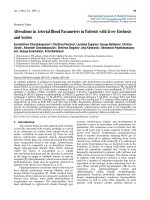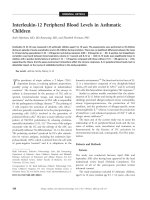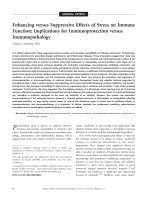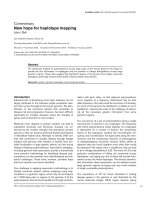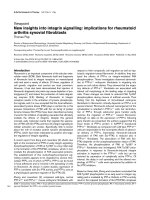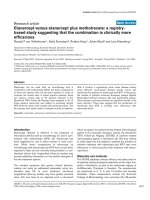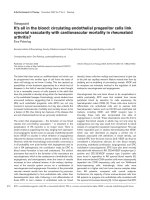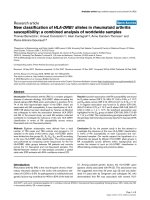Báo cáo y học: "New versus old blood – the debate continues" docx
Bạn đang xem bản rút gọn của tài liệu. Xem và tải ngay bản đầy đủ của tài liệu tại đây (119.02 KB, 2 trang )
e current standard red blood cell (RBC) storage time
of up to 42 days is not based upon a demonstrable thera-
peutic benefi t, but instead on the observed return of 70%
of the viable transfused RBCs at 24 hours after storage for
42 days or less. e structural, biochemical and immuno-
logical changes that RBCs undergo during storage are
well described, but what remains controversial is the
evidence that this storage lesion translates into adverse
clinical outcomes for patients receiving older blood. In a
previous issue of Critical Care, Ranucci and colleagues
report an adverse outcome in infants receiving older
blood during cardiopulmonary bypass (CPB) [1].
E ects of blood storage
e eff ects of storage on RBCs include changes in potassium
(increased levels), 2,3-diphosphoglycate (decreased levels),
lactate (increased levels), pH (decreased values), glucose
(decreased levels), adenosine triphosphate (decreased
levels), methaemoglobin (increased levels), red cell
structure (from biconcave disc, to echinocytes and then
to spherocytes), and therefore red cell deformability.
Storage eff ects also include changes to the micro environ-
ment with reduced levels of S-nitrosohaemoglobin and
nitric oxide. Prolonged storage prior to transfusion also
results in an immunomodulatory eff ect, fi rst described by
Opelz and colleagues who demonstrated reduced
transplant rejection after stored red cell administration
[2]. is eff ect theoretically increases infection risk, by
accumulation of proinfl am matory lipids and neutrophil
priming, resulting in severely reduced neutrophil
function.
e evidence that prolonged storage of RBCs
contributes to demonstrable adverse outcomes remains
controversial, however, and is hampered by many small
retrospective studies with potential selection bias; most
evidence is also confounded by relatively recent changes
in practice such as leucodepletion of RBCs. Moreover,
there is still no consensus on what constitutes old blood,
with studies using variable defi nitions of 5, 12, 14 or 21
days. None of the prospective studies to date have shown
a correlation between the age of RBCs and adverse
outcome. Two new studies in progress should provide
further data – the Age of Blood Evaluation study
(Canadian Clinical Care Trials Group) in trauma/
intensive care patients and the Red Cell Storage Age
Study (US National Heart, Lung, and Blood Institute’s
Transfusion Medicine/Hemostasis Clinical Trials Network)
in cardiac surgery patients.
Intensive care studies
Marik and Sibbald reported in 1993 that older RBCs were
associated with a reduced intragastric pHi value (a
surrogate for gut ischaemia) and postulated that impaired
deformability of RBCs impeded microvasculature fl ow
[3]. A similar study published in 2004, however, failed to
confi rm these fi ndings [4]. Off ner and colleagues
suggested that trauma patients receiving blood stored for
>2 weeks had higher rates of infection and multiorgan
failure [5]; but these patients also received a greater
volume of transfusion, were older and had more severe
injuries. More recently, Zallen and colleagues reported in
a cohort of 63 trauma patients that those who received
older blood had a higher risk of developing multiorgan
failure [6]; yet again, however, these patients were older
and received marginally more RBCs.
Cardiac surgery studies
e largest studies in this fi eld have been performed in
cardiac surgery. Van der Watering and colleagues retro-
spectively reviewed 2,732 patients undergoing CPB [7];
Abstract
Since the inception of blood banking, re nements in
laboratory processes have allowed for progressively
longer storage times of red blood cells. Whilst
advantageous for the logistics of stock management,
the clinical impact of the duration of red blood cell
storage prior to transfusion remains uncertain, and a
topic of growing interest.
© 2010 BioMed Central Ltd
New versus old blood – the debate continues
John Laurie
1
, Duncan Wyncoll
2
and Claire Harrison*
1
See related research by Ranucci et al., />COMMENTARY
*Correspondence:
1
Department of Haematology, Guy’s and St Thomas’ NHS Foundation Trust,
London SE1 7EH, UK
Full list of author information is available at the end of the article
Laurie et al. Critical Care 2010, 14:130
/>© 2010 BioMed Central Ltd
univariate analysis, but not multivariate analysis, suggested
a correlation between storage time and survival. In 2008
Koch and colleagues evaluated an even larger patient
group of cardiac surgical cases who received RBCs either
≤14 days old or >15 days old [8]. eir results indicated
excess inhospital mortality associated with older blood,
but these patients were also more likely to have received
more RBCs.
ese retrospective studies are now added to by that of
Ranucci and colleagues in a previous issue of Critical
Care, who evaluated outcome in 239 infants receiving
blood as either a CPB pump prime or an intra/post-
operative top-up transfusion according to whether this
blood was ≤4 days old or older. Of 192 infants receiving
CPB prime blood, the authors concluded that older blood
recipients were more likely to have pulmonary complica-
tions. After adjusting for other possible confounders, the
RBC storage time remained an independent predictor of
major morbidity, although the same association was not
found for patients receiving RBCs after CPB.
Red cell transfusion in the critically ill continues to
raise many questions – including whether the storage
duration of red cells aff ects measurable outcomes;
whether leucodepletion results in fewer storage asso-
ciated complications; the eff ect of red cell irradiation on
relevant outcomes; and, fi nally, the appropriate target
haemoglobin level in the preoperative, bleeding and
stable critically ill patient.
Clearly, more robust evidence from prospective trials is
required to support the therapeutic use of blood trans-
fusion in the critically ill, or uncertainty will remain.
Abbreviations
CPB, cardiopulmonary bypass; RBC, red blood cell.
Author details
1
Department of Haematology, Guy’s and St Thomas’ NHS Foundation Trust,
London SE1 7EH, UK.
2
Department of Intensive Care, Guy’s and St Thomas’ NHS
Foundation Trust, London SE1 7EH, UK
Competing interests
DW is a co-investigator in the RELIEVE study; A feasibility randomized trial
comparing restrictive and liberal blood transfusion strategies in intensive care
patients.
Published: 12 March 2010
References
1. Ranucci M, Carlucci C, Isgrò G, Boncilli A, De Benedetti D, De la Torre T, Brozzi
S, Frigiola A: Duration of red cell storage and outcomes in pediatric cardiac
surgery: an association found for pump prime blood. Crit Care 2009,
13:R207.
2. Opelz G, Sengar DP, Mickey MR, Terasaki Pl: E ect of blood transfusion on
subsequent kidney transplants. Transplant Proc 1973, 5:253-259.
3. Marik PE, Sibbald WJ: E ect stored-blood transfusion on oxygen delivery in
patients with sepsis. JAMA 1993, 269:3024-3029.
4. Walsh TS, McArdle F, McLellan SA, Maciver C, Maginnis M, Prescott RJ,
McClelland DB: Does the storage time of transfused red blood cells
in uence regional or global indexes of tissue oxygenation in anaemic
critically ill patients? Crit Care Med 2004, 32:364-371.
5. O ner PJ, Moore EE, Bi WL, Johnson JL, Silliman CC: Increased rate of
infection associated with transfusion of old blood after severe injury. Arch
Surg 2002, 137:711-716.
6. Zallen G, O ner PJ, Moore EE, Blackwell J, Ciesla DJ, Gabriel J, Denny C,
Silliman CC: Age of transfused blood is an independent risk factor for post
injury multiple organ failure. Am J Surg 1999, 178:570-572.
7. Van der Watering L, Lorinser J, Versteegh M, Westendord R, Brand A: E ects of
storage time of red cell transfusions on the prognosis of coronary artery
bypass graft patients. Transfusion 2006, 46:1712-1718.
8. Koch CG, Li L, Sessler DI, Figueroa P, Hoeltge GA, Mihaljevic T, Blackstone EH:
Duration of red-cell storage and complications after cardiac surgery.
NEngl J Med 2008, 358:1229-1239.
doi:10.1186/cc8878
Cite this article as: Laurie J, et al.: New versus old blood – the debate
continues. Critical Care 2010, 14:130.
Laurie et al. Critical Care 2010, 14:130
/>Page 2 of 2

